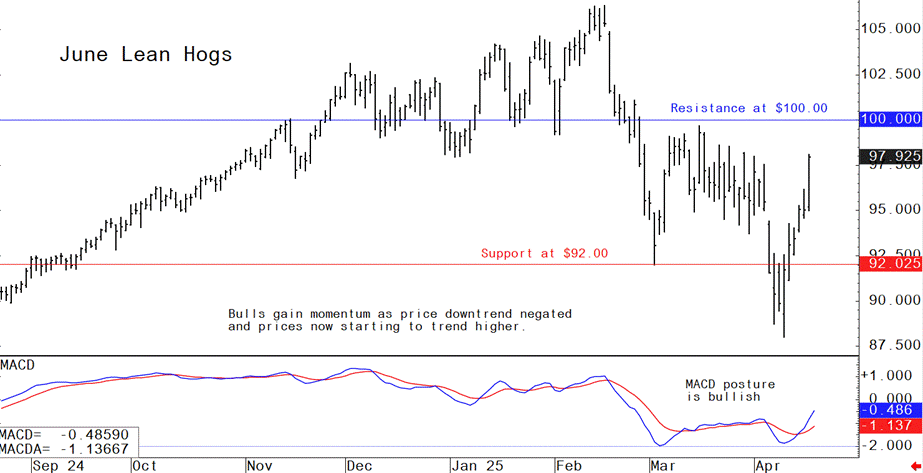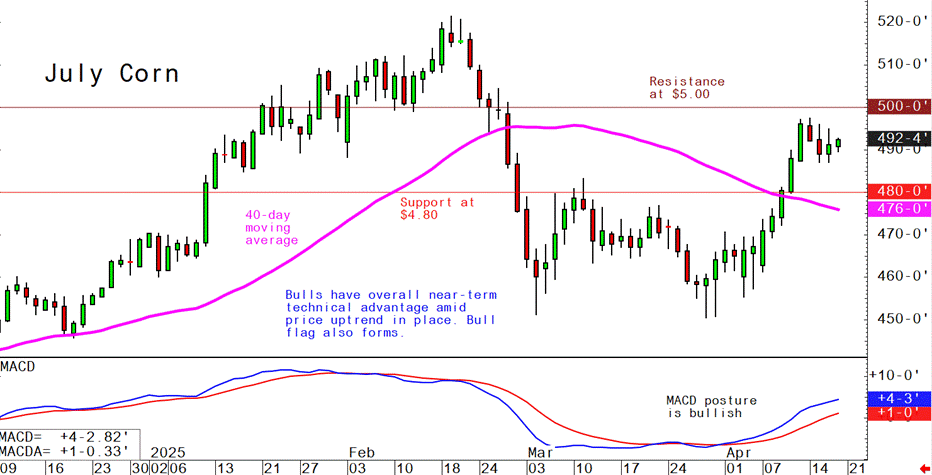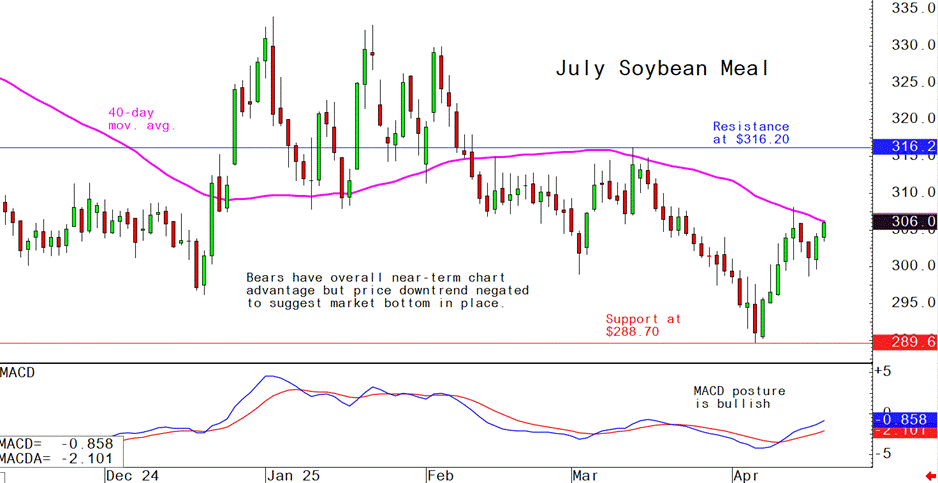



Pig outlook: Lean hog futures bulls come to life
Livestock analyst Jim Wyckoff reports on global pig newsThe lean hog futures market this week has seen short covering from the bears and perceived value buying from the bulls. The chart-based traders also likely did some buying as June hogs are starting to trend higher. Solid gains in cattle futures markets this week also likely spilled over into buying interest in hog futures. The gains in lean hog futures came despite persistent cash hog market weakness. The latest CME lean hog index is down another 63 cents to $85.37 as of April 14, marking 10 straight sessions of losses. The national direct five-day rolling average cash hog price quote today is $85.13. The noon pork report Wednesday showed pork cutout value rose 89 cents to $92.62, led by gains in ribs. Rising pork cutout values have been encouraging, with a coinciding increase in movement indicating solid demand. Grocers are ramping up pork purchases for the summer grilling season.
Latest USDA and other news regarding the global pork industry
Weekly USDA US pork export sales
Pork: Net sales of 20,500 MT for 2025 were down 14 percent from the previous week and 35 percent from the prior 4-week average. Increases were primarily for Japan (7,100 MT, including decreases of 200 MT), Mexico (3,200 MT, including decreases of 200 MT), South Korea (2,300 MT, including decreases of 1,300 MT), Colombia (2,100 MT, including decreases of 100 MT), and Canada (1,900 MT, including decreases of 100 MT). Exports of 30,900 MT were up 3 percent from the previous week, but down 3 percent from the prior 4-week average. The destinations were primarily to Mexico (11,100 MT), South Korea (5,300 MT), Japan (4,400 MT), China (2,900 MT), and Colombia (2,000 MT).
China’s Q1 pork output rises 1.2%
China’s pork output rose 1.2% from year-ago in the first quarter to 16.02 MMT. A total of 194.76 million hogs were slaughtered from January to March, a 0.1% increase from the same period last year. Typically, pork output rises in the first quarter due to increased hog slaughter ahead of the Lunar New Year holiday. But the sector remains under pressure, with oversupply and slow demand continuing to weigh on prices and profits. Authorities have taken steps to curb oversupply, as Beijing in 2024 lowered the national target for normal retention of breeding sows to 39 million head from 41 million.
USDA Livestock Outlook: April 2025
Summary
Beef/Cattle: The 2025 beef production outlook is raised by 15 million pounds from last month to 26.700 billion pounds. Projections for cattle prices are higher as slaughter steer prices are raised to $205.51 per hundredweight (cwt) and feeder steer prices are raised to $281.03 per cwt. Beef import and export forecasts are lowered to 4.860 billion pounds and 2.685 billion pounds, respectively.
Dairy: The 2025 milk production forecast is increased to 226.9 (+0.7) billion pounds due to higher expected cow numbers (+25,000) and anticipated improved milk yield per cow (+10 pounds). Dairy product price forecasts are adjusted lower from last month's forecasts, including Cheddar cheese $1.790 (-2.0 cents), dry whey $0.510 (-1.50 cents), butter $2.445 (-7.0 cents), and non-fat dry milk (NDM) $1.22 (-3.5 cents). With lower price forecasts across main dairy products, the forecasts for Class III and IV milk prices are also revised downward from the previous projections to $17.60 (-$0.35) and $18.20 (-$0.60) per hundredweight (cwt), respectively. The all-milk price for 2025 is now forecast at $21.10 per cwt, down $0.50 from last month's forecast.
Pork/Hogs: Information from the Quarterly Hogs and Pigs report published in March supports a moderate reduction in 2025 pork production. Total 2025 pork production is forecast at 28.1 billion pounds, down about 350 million pounds (1.2 percent) from the previous forecast in March. Prices of 2025 live equivalent 51–52 percent lean hogs are expected to average $61.14 per hundredweight, about 1 percent below average prices in 2024. While domestic pork demand remains robust, trade-related uncertainty on world markets is projected to pare down 2025 pork exports to about 7 billion pounds, about 2 percent below exports last year.
Poultry/Eggs: Projected broiler production in 2025 is adjusted up reflecting heavier weights and favorable margins, but projected broiler exports are lowered. Broiler prices are adjusted up in 2025 on recent price data and healthy demand. Projected table egg production is adjusted down on recent flock losses; egg and egg product imports are projected to increase while exports are projected to decrease from 2024. Projected egg prices in 2025 are adjusted down on recent price trends. Projected turkey meat production and exports are adjusted down on recent data, while prices are adjusted higher.
March Hogs and Pigs Report Shows Largely Static Pork Sector
Estimated federally inspected (FI) hog slaughter for the first quarter of 2025 finished out at 31.9 million head, 2.3 percent below numbers of a year earlier. The June–August 2024 pig crop, fractionally smaller than June–August 2023 numbers, supplied most of the hogs for first-quarter 2025 processing. The comparatively large year-over-year reduction in FI slaughter numbers may, in part, be attributed to reports of disease in some large operations in key producing Midwestern States.
The estimated FI first-quarter pork production was about 6.9 billion pounds, 2 percent lower than a year ago, with slightly heavier estimated average dressed weights offsetting a marginal amount of the effects of lower animal numbers. First-quarter prices of live equivalent 51–52 percent hogs averaged $62.57 per hundredweight, almost 14 percent higher than during the same period last year. Lower supplies of slaughter-ready hogs, and higher prices of all proteins contributed to higher hog prices in the first quarter. Commercial pork production in the second quarter is lowered 125 million pounds to about 6.8 billion pounds. The reduction is due largely to downward revisions to lighter weight categories of the September hog inventory, published in the Quarterly Hogs and Pigs report on March 27, 2025.
The current forecast for second-quarter 2025 production is almost 1 percent higher than in the same-period last year. Last month’s forecast—before publication of the March Quarterly Hogs and Pigs report—showed second-quarter pork production up 2.4 percent compared with a year earlier. Second-quarter hog prices are likely to average $63 per hundredweight, almost 4 percent lower than a year earlier. The December–February5 pig crop will supply most of the finished hogs for processing in the third quarter of 2025. The Quarterly Hogs and Pigs reported December–February farrowings of 2.892 million head, down about 1.3 percent from a year earlier, with a litter rate of 11.65 pigs per litter, yielding a pig crop of 33.7 million head, about equal with a year earlier. Third-quarter commercial pork production is forecast at 6.9 billion pounds, 2.2 percent greater than the same production period in 2024, largely due to higher expected slaughter levels and heavier expected dressed weights than the previous year. Live equivalent prices of 51–52 percent lean hogs are forecast to average $65 per hundredweight during the third quarter of 2025, more than 2 percent greater than a year earlier.
The March Hogs and Pigs report published a second set of producers’ farrowing intentions for the March–May production quarter. If producers follow through on their stated intentions, 2.913 million sows will farrow, a number fractionally lower than a year earlier. Moderate growth in litter rates would yield a March–May pig crop of less than 1 percent larger, year-over-year. Fourth quarter commercial pork production is expected to reach 7.45 billion pounds, about 3 percent above production during the same period in 2024. Hog prices in the fourth quarter are forecast at $54 per hundredweight, almost 13 percent lower than prices in the fourth quarter of 2024. Revisions and new information supplied by the March Quarterly Hogs and Pigs report point to a total of 2025 commercial pork production of 28.1 billion pounds, a decrease of about 350 million pounds, about 1.2 percent below last month’s annual forecast. For the year, live equivalent prices of 51-52 percent lean hogs are expected to average $61.14 per hundredweight, down from $61.56 per hundredweight in 2024, a reduction of nearly 1 percent. Pork Exports Year-Over-Year Lower in February U.S. pork exports in February were 5 percent lower than a year ago, at 565 million pounds. Weakness was dispersed across most major foreign markets in the Western Hemisphere: Mexico (-2 percent), Canada (-6 percent), and Colombia (-9 percent); Asia: Japan (-19 percent) and South Korea (-14 percent); and Australia (-12 percent). Shipments to China and Hong Kong, Honduras, and Guatemala were year-over-year higher.
Germany declared free of FMD
Germany has been certified as free of foot-and-mouth disease (FMD) by the World Organization for Animal Health, the country’s ag ministry said. The status of being free of the disease had been reinstated for most of Germany except the containment zone in mid-March.
China’s meat imports rise in March
China imported 550,000 MT of meat during March, up 14.2% from February. Through the first three months of this year, China imported 1.65 MMT of meat, down 2.0% from the same period last year.
The next week’s likely high-low price trading ranges:
June lean hog futures--$95.00 to $101.00 and with a sideways-higher bias
July soybean meal futures--$300.00 to $310.00, and with a sideways-higher bias
July corn futures--$4.85 to $5.05 and a sideways-higher bias
Latest analytical daily charts lean hog, soybean meal and corn futures










